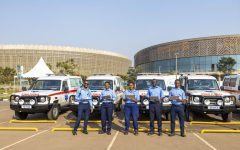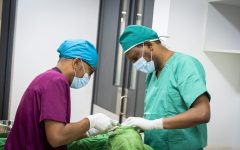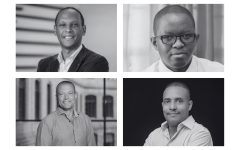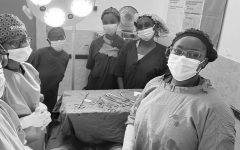Stigma, Power & Hopes: Alice Kayibanda & Moses Izabiriza talk arts & mental health ahead of Mbwira Ndumva Symposium
March 25, 2021 2021-03-25 13:40Stigma, Power & Hopes: Alice Kayibanda & Moses Izabiriza talk arts & mental health ahead of Mbwira Ndumva Symposium
Stigma, Power & Hopes: Alice Kayibanda & Moses Izabiriza talk arts & mental health ahead of Mbwira Ndumva Symposium
The devastating impacts of COVID-19 will no doubt be long-lasting, with a slow road to recovery mapped out for global economies and societies. Billions have been spent in relief funds over the last year-and-quarter, funding infrastructure, equipment and human resources to support the rapid influx of critically ill patients to hospitals and intensive care units around the world. Yet while COVID-19’s on physical health has made frontline news, it’s double threat to mental wellbeing has been less reported. Across the world, sharp spikes in those experiencing some form of mental illness have directly correlated with enforced lockdown measures, social isolation, and family grievances. And this is not new; mental health issues have, historically, affected nearly half of the global population at some stage in their lives.
It is clear that we need new ways of looking at mental health and mental health service provision, to address rising case rates globally and build future resilience to threats like COVID-19. One proven approach is through the arts. Since the start of the 21st century, there has been a major increase in research into the effects of the arts on health and well-being, showing them as evidence-based interventions for mental health issues, such as anxiety and depression. Whilst creating art can promote calm, reduce feelings of anxiety, and has proven long-term effectiveness in combating depression, observers of art can experience catharsis, shared relief from trauma, and greater awareness of their mental state through mindfulness.
Two artists pioneering this approach in Rwanda are Alice Kayibanda and Moses Izabiriza. Alice, a Kigali based photographer, uses compelling visual storytelling to help her heal from depression as a result of a psychologically abusive relationship. Moses, a Rwandan modern narrative painter and co-founder of one Kigali’s Kuuru Art Space, provides a platform for collaborative creativity aimed at changing lives, channels issues of identity through his paintings. During Hamwe Festival 2020, a UGHE-hosted annual event facilitating collaboration between global health professionals and creatives, Alice and Moses formed part of a residency for a collective arts project – Stigma, Power & Hopes – aimed at more deeply exploring the science behind mental illness through a creative medium. The four Rwandan artists used the residency as a safe and stimulating platform for exploring the perspectives, attitudes and beliefs around mental health in the Rwandan context.
Stigma, Power & Hopes will be discussed at the upcoming Mbwira Ndumva Symposium, a dynamic event co-hosted by UGHE’s Hamwe Festival and the University of Rwanda, aiming to explore the creative expression as a healing mechanism in mental health. Ahead of the event, we caught up with Alice and Moses to share how their art has helped them, and others.
Take a Virtual Tour of Stigma, Power & Hopes here.
***

Q. Art, specifically photography, is evidently a very powerful means of healing for you, Alice. Can you tell me a little more about the process of creative self expression, and how it supports trauma recovery?
Alice: When I started photography, I was not doing it for other people but for myself. I wanted to prove to myself that I could accomplish something. People told me that I was smart and intelligent, but I felt like a failure. When I started photographing, I wanted to start and take and finish it and learn somethingI never thought that I would become a professional; photographer – it was something I could do for myself. But when I shared it with other people, they encouraged me to share it more widely, and when I did so, I started to feel better, to aspire to be better. I also started to become interested in other people, to connect with people, something I hadn’t wanted to do previously.
When I started out in the profession, street photography allowed me to take photos of people but not talk to them. As I advanced, I actually wanted to talk to people and learn from them. Before I didn’t know that I loved people so much, but through photography I heard other people’s stories, and had empathy for them, to the extent I would follow-up and check in with them. I will say that it is about connecting with other people. Seeing that you are not the only one.
Q. Moses, can you tell me a little about how you became an artist, and the journey to founding Kigali’s Kuuru Art Space. What is the impact of collaboration and solidarity between creative communities, and what impact does this have in addressing often complex social issues?
Moses: I started art at a very young age. In primary school, I would draw on the desk and create toys out of wires. I never actually formally studied art. But when I started creating art, I found it was a great way for me to heal myself. I lost my mum in the 1994 Genocide against the Tutsi when I was two years old. I was just a kid at the time and had never got a chance to talk with her. I found art was a good way for me to relieve myself and to discover more about myself. In 2012, I finished high school which is when I started art professionally. I started at a studio called Iviko and worked with them until 2016. My friends and my friends came together to create an art space where young talented people can come and use the space to explore. We start with this mission. We created artwork to change belief through creativity. We also wanted to change our art scene and reflect the time.
I believe that an artist’s life is like a cycle reflecting the life that we live in everyday. When you are painting you often have feelings – you are feeling good, or feeling bad – and life is a concept of bad and good things. For me, I believe that if you create an artwork, you engage with the community and when they see the artwork, they see themselves, they see their story. So it is a way of communicating, as before I even go about explaining why I have created an artwork, the artwork is already speaking directly to the audience. You sometimes don’t know how much someone in your audience will relate to your art.

Q. How has this global pandemic or projects within this period affected the way you work, or communicate through it?
Alice: I was trained as a photojournalist, but in the back of my mind I’d always wanted to work on mental health but didnt know where to start. I never thought I would talk about my personal experience; it was something I had kept secret, or perhaps thought no one would be interested in hearing my story. I was so fortunate to get the chance to work with Hamwe Festival in November last year. It challenged me to move from photojournalism to another kind of photography – a type of photography I actually found easier. With photojournalism you shoot reality – what you see – but I had this sense of anxiety on every project not because I am a perfectionist, but rather because I was worried that I was somehow imposing myself on people, and that they were reluctantly participating in the project. You see, I feel what other people feel, and so it can be very overwhelming as a photojournalist.
When I used the kind of technique I used for Hamwe Festival, I was very calm. I never thought I’d enjoy or be helped by a project like this so much. I had become overwhelmed by listening to constant COVID-19 updates on the radio and TV, and worried about people losing their jobs, and about my kids being impacted by social distancing. I think working on the project helped me to manage my anxiety in a way that I didn’t think possible.
Q. What have you learnt about the science of mental health through your Hamwe Festival Stigma, Power & Hopes residency?
Moses: It found it a really fascinating residency. Throughout the project, I started to realize that before this I had had the wrong information about mental health which I now understand to be a really widespread misunderstanding in some communities in Rwanda. I got a chance to meet different specialists, as well as hearing testimonials from people suffering from mental health. I understood that mental health can be inherited; from your mother even when she is pregnant. I received so much information about mental health that blew my mind and made me question myself and how best I could contribute to the community and talk through my art. I started to question whether I am strong enough to go out there and inspire and heal other people through my art?
Through the residency I learnt that I needed to dig deep to explore myself – to know myself better and what to do when I get depressed. I have had a mental disorder for many years but I didn’t really recognize it. When i felt bad I just started to draw or paint. This whole process of working with other artists on the residency has been an amazing journey of self discovery and made me want to do further research of my own into it – to go out there and actually talk to people. We all have mental health issues, and I got to learn to be strong and to understand that you can’t give what you don’t have. It is really hard to have an open conversation about mental health without offending someone indirectly. So I learnt to create a room in my heart to listen to others before criticizing or reacting to them.
Q. What message do you hope to convey to the public through this collective mental health arts project? How might it serve to support others suffering from mental illness?
Alice: My message is simple; that anyone can suffer from mental health. When I was doing the project I asked myself what the best way to talk about mental health would be. I came to the conclusion that it was to talk about my own experience. I am known as someone who laughs all the time – I don’t think anyone knew I suffered from depression. I remember clearly a time in 2010 when working on a production project with a group of colleagues. It was suggested that the film should focus on mental illness and suicide. This idea was quickly rejected – they said mental illness and suicide didn’t exist here, even whilst at that stage I was searching online for how i could end my life. I continued denying to myself that I had a problem, and hiding this from colleagues knew. When it became very overwhelming, it became harder to hide as I started to cry a lot.
The reason I took up the Hamwe Festival residency was to show others that there is no shame in revealing that you suffer from depression or other mental health issues. When we shame people who want to tell their story, that is when things get worse. When I talk about trauma I have trouble seeing how people view art, how people connect with it as observers. I always talk as an artist and never claim to understand how art should make people feel. But it is a good way of making this a shared experience, and letting people know they’re not alone.
Q. Why do you think platforms like Hamwe Festival are critical to driving awareness and uptake of creative methodologies in mental health services?
Alice: As artists we have a very visual and easy way to show problems that society is suffering from and a language that other people can understand – an easy language. When we talk to medical professionals you can get lost in scientific language. Through artists and art it is very easy to show to the audience what you mean and it is a medium that allows people to easily connect and find a human element in your story.
Moses: Here in Rwanda we have been looking for something like Hamwe for a long time. We still have big gaps in service provision in our communities, and lots of people live with trauma without knowing or recognizing this. The platform has created a bridge between health sectors and creative industries. Health sectors and professionals spend a lot of time focussing on treating patients with drugs, but drugs play a very small part in healing. A big part of healing is actually seeing oneself coming back into society without stigma – and the Hamwe platform plays a very big role as art is a medium of communication. Art therapy can increase safe self discovery, relieve stress, and play a big part in helping see yourself again within your communities.
***
Tune in on the 26th March for Mbwira Ndumva, a Symposium co-hosted by Hamwe Festival & the University of Rwanda. Register here.







